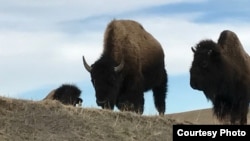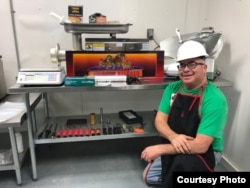The Oglala Lakota tribe on the Pine Ridge Reservation in South Dakota is one step closer to taking control of the food it eats: The Charging Buffalo Meat House will open shortly for business, processing and packaging buffalo meat from the tribe’s own herd.
Buffalo were for centuries the lifeline of Plains tribes, a source of food, clothing, shelter and even weapons and utensils. In the 19th century, the U.S. Army recognized the best way to force Indians onto reservations was to destroy their greatest resource. Aided by sportsmen and trophy hunters, the Army slaughtered buffalo to near extinction.
Tribes were forced to abandon their traditional diet and survive off government rations of flour, oil and coffee; these were gradually replaced by processed, packaged foods. There’s only one supermarket on the reservation, but with unemployment running at about 80 percent on Pine Ridge, many must rely on cheap, filling food that is low in nutrition and high in fat. Today, obesity, diabetes and heart disease are rampant on Pine Ridge, and life expectancy is the lowest in the nation.
Charles “Bamm” Brewer believes the solution for Lakota lies in returning to a traditional diet of wild fruits and vegetables—and, of course, buffalo.
Twenty years ago, he explains, he had a vision while riding in a buffalo roundup, an annual affair in which the tribe rounds up animals that have strayed from the herd.
“As the buffalo ran, they kicked up snow and dirt,” he remembered, “and they gave off hot steam. And all of this rose up into a huge cloud. And I ran right into that cloud with them."
That’s when he believes he stepped into the past, living the experience of his ancestors. “And they gifted me a message: 'Bring the buffalo back to the people.'”
He began small, taking out a loan to fence in his family’s land allotment, about 325 hectares (800 acres), and slowly, he began building up a herd of stock culled from federally-owned herds in nearby national parks.
“Every other year, the national park has surplus, and to be eligible to buy, tribes have to have pastures big enough to hold the buffalo. So, the tribe created a sharecrop program, where tribal members can turn their land into buffalo pastures and get 60 percent of the calf crop.”
Today his herd amounts to about 50, and buffalo has been part of his family’s diet for years.
The Lakota, like other tribes, never killed buffalo for sport.
“In our culture, when we hunt the buffalo, we say a special prayer to thank the animal for giving its life,” he said.
Up until now, Brewer would kill a buffalo out in the field, then haul the animal back to the family garage where he would hand-butcher it.
About seven years ago, Brewer took a job as food program manager for One Spirit, a local non-profit group that distributes fresh food and produce to families in need. It occurred to him that if One Spirit could build a meat-processing plant, it could include buffalo meat in those distributions.
One Spirit launched a fundraising campaign, and donors heeded the call. Today, the Charging Buffalo Meat House is only about $15,000 away from becoming fully operational; it lacks only a heating and air conditioning system to begin operating as a “custom exempt” meat processing facility, that is, gaining state approval to process and package buffalo meat for individual owners and hunters.
One Spirit hopes to someday gain federal Food and Drug Administration approval and enter the open market. These days, there’s a big demand for buffalo meat, a $340-million industry, according to the National Bison Association.
“But by building the Meat House, we aren’t just providing employment,” said One Spirit’s director Jeri Baker. “We’re also looking at all the things that could be done with the buffalo besides just having meat to eat.”
One Spirit is looking to revive the traditional art of brain-tanning raw buffalo hides, and it has enlisted one of the few existing brain tanners to teach others his skill.
“It's a very labor-intensive process that uses an emulsified solution of animal brain and water to provide outstanding absorbency to the final product,” Baker explained. “What you get at the end of your sweat and toil is an exceptionally soft hide that stays pliable even after it gets wet. And that’s a potential for a whole new industry.”
Recently, the Meat House distributed its first buffalo meat to tribe members—250 one-kilo bags.
“We got good compliments,” Brewer said. Then he laughed, relating how one tribe member turned up his nose at the offering, saying, “Eww, we don’t eat buffalo.”
“That just shows us just how much this project is needed,” he said.












